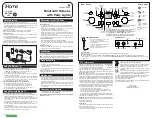
4.2.12 HEATING TANK/ELEMENT
WARNING
!
Hazardous voltage:
Before wiring, servicing or cleaning
the heating system, turn off the power and follow your
organization’s lockout and tagout procedure. Failure to do
so could allow others to turn on the power unexpectedly,
resulting in harmful or fatal electrical shock.
At least once per year, clean the interior of the heating
tank and the heating element with a wire brush and/or
damp cloth. Periodically check the sediment build-up
around the element loops. Any scaling or build-up will
shorten element life.
To replace the heating element or perform routine
maintenance, use the following procedures.
. The wattage and phase of the heating element are
listed on the identification plate on the outside of the
element
(B)
. Reference this label for the replacement
part number.
1.
De-energize the heating system. Allow fluid to cool.
2.
Close isolation valves. Drain the fluid from the
heating tank
(E)
.
See
SECTION 4.2.4
3.
Remove the cap
(A)
from the heating element
service entrance enclosure.
4.
Note your unit’s jumper configuration.
NOTICE!
Elements are configured from
the factory. Retain original jumper placement
during element reassembly. Altering element
configuration or jumper placement may cause
heating system failure.
NOTE:
Replacement elements may be a different
jumper configuration.
5.
Disconnect the ground (green/yellow) and power
electrical wires from the terminals inside the cap.
6.
Unscrew cable gland
(F)
from conduit connector
entrance
(H)
. Remove electrical cable and wires
from the heating element.
.
7.
Loosen V-clamp nut to remove V-clamp
(C)
. Slide
the heating element out of tank as shown.
8.
Replace the heating element
(G)
or perform the
necessary cleaning procedure. Ensure the O-ring
(D)
is intact and in place before securing V-Clamp.
4.2.13 REASSEMBLY OF HEATING
ELEMENT AND TANK
To reassemble the heating element and tank, follow the
steps listed in
SECTION 4.2.12
reverse order
. Make
sure the ground and power electrical wires are properly
reconnected using the provided nuts.
Tighten the following components:
•
V-clamp nut
(C)
to 20 N m (180 lbf in)
•
Element terminal nuts to 1.6 N m (14 lbf in)
NOTE:
System wattage may be changed by replacing
the element assembly. Prior to changing
wattage, contact Hotstart with your system’s
part number and serial number to ensure it is
safe to do so, or if other components need to
be changed for proper operation.
E
D
C
F
G
H
B
A
Figure 16. Removing and replacing the heating element.
The heating system should be drained, cleaned and flushed
annually. See
SECTION 4.3
A.
Element service
entrance cap
B.
Element identification
plate
C.
V-clamp
D.
O-ring
E.
Tank
F.
Element cable grip and
element cable
G.
Element
H.
Cable connector
entrance
THREE-PHASE
DELTA
THREE-PHASE
WYE
SINGLE-PHASE
PARALLEL
SINGLE-PHASE
SERIES
THREE-PHASE
DELTA
THREE-PHASE
WYE
SINGLE-PHASE
PARALLEL
SINGLE-PHASE
SERIES
THREE-PHASE
DELTA
THREE-PHASE
WYE
SINGLE-PHASE
PARALLEL
SINGLE-PHASE
SERIES
THREE-PHASE
DELTA
THREE-PHASE
WYE
SINGLE-PHASE
PARALLEL
SINGLE-PHASE
SERIES
Figure 17.
Heating element jumper configurations. Replacement
elements may be a different jumper configuration.
Summary of Contents for CLM
Page 2: ......
Page 6: ...iv installation operation manual cmm clm heating system ...



































